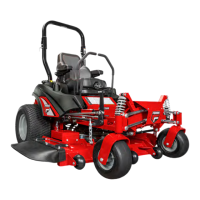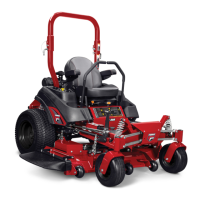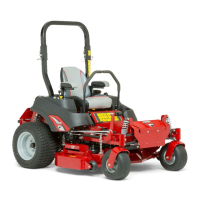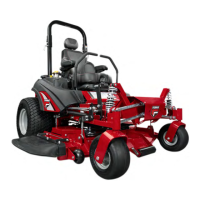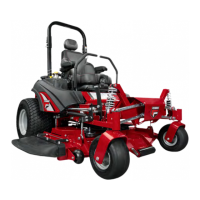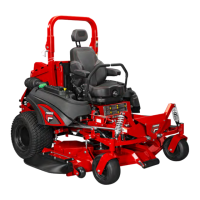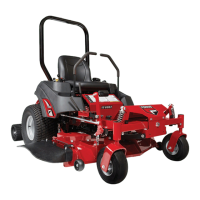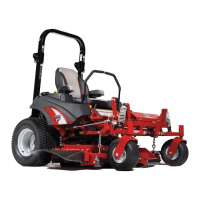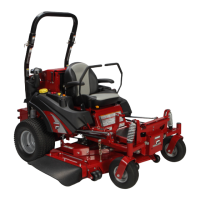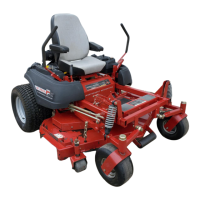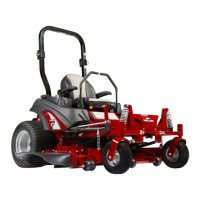Do you have a question about the Ferris ISX2200 and is the answer not in the manual?
Locates and explains the product identification tag for model and serial numbers.
Explains the markings and symbols found on the CE identification tag.
Informs about chemicals that may cause cancer or reproductive harm.
Provides essential rules for safe operation to prevent injury or damage.
Details measures to keep children away from the operating area to prevent accidents.
Advises on safe operation on slopes, including limitations and precautions.
Explains how mower blades can throw debris and how to prevent injuries.
Warns about hazards from moving parts and how to stay safe.
Instructions on how to use and maintain the roll bar for rollover protection.
Advises on maintaining safe distances from retaining walls, drop-offs, and water.
Reminds operator to check for overhead clearances and avoid contact.
Provides methods to measure lawn slopes using tools or smartphone apps.
Details safe practices for handling gasoline and storing fuel-powered equipment.
Warns against operating the unit in enclosed areas due to carbon monoxide risk.
Emphasizes the need for training, understanding manuals, and operator responsibility.
Outlines essential preparation steps before operating the machine.
Ensures all safety systems and controls are functioning correctly before operation.
Details critical rules for operating the machine, including slopes and reverse.
Safety guidelines for towing equipment with the zero-turn rider.
Information about emissions-related components and their impact.
Provides instructions for safe handling of gasoline to prevent fire and explosion.
Lists unit maintenance tasks and their recommended intervals.
Lists engine maintenance tasks and their recommended intervals.
Warns about using the roll bar correctly for rollover protection.
Details procedures for inspecting the roll bar structure for damage or wear.
Outlines how to inspect and maintain the seat belt for proper function.
Explains the importance of reading and understanding safety decals on the unit.
Lists and illustrates various safety decals and their corresponding part numbers.
Explains common safety icons representing hazards like amputation, fire, and tipping.
Details safety icons related to specific risks like thrown objects, slopes, and dismemberment.
Lists tests to verify the proper function of the safety interlock system.
Describes the function and location of individual controls on the machine.
Identifies and explains the function of various controls like pedals, levers, and gauges.
Explains how the ground speed control levers manage speed and direction.
Explains the fuel level gauge and how to engage/disengage the parking brake.
Details seat adjustment and the function of the retractable seat belt.
Describes the fuel selector valve, tank cap, and transmission release levers.
Explains the functions of the ignition switch, PTO switch, hour meter, and indicator lamps.
Important steps and familiarization before initial operation of the tractor.
Key warnings regarding passengers, stopping procedures, fire hazards, and fuel.
Lists checks for oil, hardware, seat position, fuel, and hydraulic oil before starting.
Step-by-step guide for starting the fuel-injected engine.
Instructions for practicing smooth forward movement and speed control.
Guidance on practicing safe reverse operation and control.
Instructions for practicing turning around corners and turning in place.
Demonstrates how to perform a zero-turn maneuver at the end of a row.
Step-by-step guide for starting the engine, setting height, and engaging the mower.
Advice on setting the cutting height for optimal grass health and appearance.
Guidelines on when to mow, blade sharpness, and mowing in different conditions.
Recommends patterns for cutting grass for best results and appearance.
Explains how to broadcast (side-discharge) clippings evenly across the lawn.
Details the process and conditions for effective mulching of grass clippings.
Instructions on how to check and refill the fuel tank safely.
Procedure for checking the engine oil level before each use.
Overview of the EFI system, its monitoring, and servicing requirements.
Identifies the location and purpose of the unit's replaceable fuses.
Procedure for checking and filling the transmission oil level.
Steps to remove air from the hydraulic system to ensure proper operation.
Lists points requiring grease lubrication, including types of grease.
Lists points requiring oil lubrication for smooth operation.
Instructions for lubricating the ForeFront suspension control arms.
Procedure for lubricating the front caster wheels annually.
How to adjust the operator's seat for comfort.
Explains how to adjust control levers for alignment, placement, and height.
How to adjust levers to balance speed and prevent veering.
Detailed steps for adjusting the mower deck's cutting height.
How to adjust the deck lift foot pedal for optimal operator comfort.
Procedure for removing and reinstalling the floor pan for deck access.
Guidelines for storing the unit for short periods, focusing on fuel safety.
Steps for preparing the unit for extended off-season storage.
Lists unit maintenance tasks and their recommended intervals.
Lists engine maintenance tasks and their recommended intervals.
Technical details of the engine, including make, model, and electrical system.
Details fuel capacity, tire sizes, inflation pressures, and transmission types.
Provides overall dimensions and weight for different deck models.
Outlines the terms, conditions, and periods of the limited warranty.
Explains where and how to obtain warranty service.
Lists conditions and actions that void the warranty, like improper use or maintenance.
Locates and explains the product identification tag for model and serial numbers.
Explains the markings and symbols found on the CE identification tag.
Informs about chemicals that may cause cancer or reproductive harm.
Provides essential rules for safe operation to prevent injury or damage.
Details measures to keep children away from the operating area to prevent accidents.
Advises on safe operation on slopes, including limitations and precautions.
Explains how mower blades can throw debris and how to prevent injuries.
Warns about hazards from moving parts and how to stay safe.
Instructions on how to use and maintain the roll bar for rollover protection.
Advises on maintaining safe distances from retaining walls, drop-offs, and water.
Reminds operator to check for overhead clearances and avoid contact.
Provides methods to measure lawn slopes using tools or smartphone apps.
Details safe practices for handling gasoline and storing fuel-powered equipment.
Warns against operating the unit in enclosed areas due to carbon monoxide risk.
Emphasizes the need for training, understanding manuals, and operator responsibility.
Outlines essential preparation steps before operating the machine.
Ensures all safety systems and controls are functioning correctly before operation.
Details critical rules for operating the machine, including slopes and reverse.
Safety guidelines for towing equipment with the zero-turn rider.
Information about emissions-related components and their impact.
Provides instructions for safe handling of gasoline to prevent fire and explosion.
Lists unit maintenance tasks and their recommended intervals.
Lists engine maintenance tasks and their recommended intervals.
Warns about using the roll bar correctly for rollover protection.
Details procedures for inspecting the roll bar structure for damage or wear.
Outlines how to inspect and maintain the seat belt for proper function.
Explains the importance of reading and understanding safety decals on the unit.
Lists and illustrates various safety decals and their corresponding part numbers.
Explains common safety icons representing hazards like amputation, fire, and tipping.
Details safety icons related to specific risks like thrown objects, slopes, and dismemberment.
Lists tests to verify the proper function of the safety interlock system.
Describes the function and location of individual controls on the machine.
Identifies and explains the function of various controls like pedals, levers, and gauges.
Explains how the ground speed control levers manage speed and direction.
Explains the fuel level gauge and how to engage/disengage the parking brake.
Details seat adjustment and the function of the retractable seat belt.
Describes the fuel selector valve, tank cap, and transmission release levers.
Explains the functions of the ignition switch, PTO switch, hour meter, and indicator lamps.
Important steps and familiarization before initial operation of the tractor.
Key warnings regarding passengers, stopping procedures, fire hazards, and fuel.
Lists checks for oil, hardware, seat position, fuel, and hydraulic oil before starting.
Step-by-step guide for starting the fuel-injected engine.
Instructions for practicing smooth forward movement and speed control.
Guidance on practicing safe reverse operation and control.
Instructions for practicing turning around corners and turning in place.
Demonstrates how to perform a zero-turn maneuver at the end of a row.
Step-by-step guide for starting the engine, setting height, and engaging the mower.
Advice on setting the cutting height for optimal grass health and appearance.
Guidelines on when to mow, blade sharpness, and mowing in different conditions.
Recommends patterns for cutting grass for best results and appearance.
Explains how to broadcast (side-discharge) clippings evenly across the lawn.
Details the process and conditions for effective mulching of grass clippings.
Instructions on how to check and refill the fuel tank safely.
Procedure for checking the engine oil level before each use.
Overview of the EFI system, its monitoring, and servicing requirements.
Identifies the location and purpose of the unit's replaceable fuses.
Procedure for checking and filling the transmission oil level.
Steps to remove air from the hydraulic system to ensure proper operation.
Lists points requiring grease lubrication, including types of grease.
Lists points requiring oil lubrication for smooth operation.
Instructions for lubricating the ForeFront suspension control arms.
Procedure for lubricating the front caster wheels annually.
How to adjust the operator's seat for comfort.
Explains how to adjust control levers for alignment, placement, and height.
How to adjust levers to balance speed and prevent veering.
Detailed steps for adjusting the mower deck's cutting height.
How to adjust the deck lift foot pedal for optimal operator comfort.
Procedure for removing and reinstalling the floor pan for deck access.
Guidelines for storing the unit for short periods, focusing on fuel safety.
Steps for preparing the unit for extended off-season storage.
Lists unit maintenance tasks and their recommended intervals.
Lists engine maintenance tasks and their recommended intervals.
Technical details of the engine, including make, model, and electrical system.
Details fuel capacity, tire sizes, inflation pressures, and transmission types.
Provides overall dimensions and weight for different deck models.
Outlines the terms, conditions, and periods of the limited warranty.
Explains where and how to obtain warranty service.
Lists conditions and actions that void the warranty, like improper use or maintenance.
| Brand | Ferris |
|---|---|
| Model | ISX2200 |
| Category | Lawn Mower |
| Language | English |
